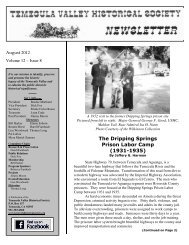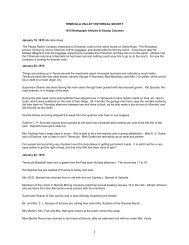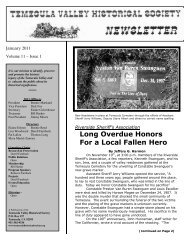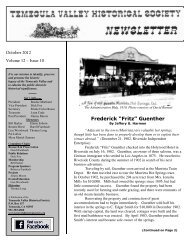Brief History of the First 50+ years of Riverside County Sheriff's ...
Brief History of the First 50+ years of Riverside County Sheriff's ...
Brief History of the First 50+ years of Riverside County Sheriff's ...
- No tags were found...
Create successful ePaper yourself
Turn your PDF publications into a flip-book with our unique Google optimized e-Paper software.
September 2011Volume 11 – Issue 9It is our mission to identify, preserveand promote <strong>the</strong> historiclegacy <strong>of</strong> <strong>the</strong> Temecula Valley andto educate <strong>the</strong> public about itshistorical significance._____2011 OfficersPresident Bonnie MartlandVice President Dick FoxSecretary Elaine CulverhouseTreasurer Bill HarkerPast President Jimmy MooreDirectorsElaine Eshom Bonnie ReedLisa Woodward Darell FarnbachPat Lallou Thomas LongMyra Masiel-ZamoraCommittee ChairsResearch & PreservationDarell FarnbachPublic RelationsDick FoxMembershipBill HarkerProgram SpeakersRebecca FarnbachProjectsJimmy MooreEvents/EducationLisa WoodwardHistorianThomas LongA Publication <strong>of</strong> <strong>the</strong>Temecula Valley Historical SocietyP.O. Box 157Temecula, CA 92593951-303-6860www.temeculahistoricalsociety.orgFred Swope, 1 st SheriffW. B. Johnson, 2 nd Sheriff1893 – 1895 1895 - 1899Area Law Enforcement Snapshot<strong>Brief</strong> <strong>History</strong> <strong>of</strong> <strong>the</strong> <strong>First</strong> <strong>50+</strong> <strong>years</strong> <strong>of</strong><strong>Riverside</strong> <strong>County</strong> Sheriff’s DepartmentBy Duane PreimsbergerCalifornia’s 58 Counties began to evolve beginning with statehood in 1850when <strong>the</strong> 27 original Counties were formed. At <strong>the</strong> sou<strong>the</strong>rn end <strong>of</strong> <strong>the</strong> State,San Diego was gigantic, encompassing almost 20% <strong>of</strong> California with territorynorth toward Mariposa. It included <strong>the</strong> areas now known as San Bernardinoand <strong>Riverside</strong>. San Bernardino <strong>County</strong> was created in 1853 and <strong>the</strong> areaencompassing today’s <strong>Riverside</strong> was <strong>the</strong>n within <strong>the</strong> two saintly territories.As early as 1890, rumblings were heard, proposing <strong>the</strong> creation <strong>of</strong> a newcounty that would take area from both San Diego and San Bernardino.Opposition was swift, some declared that a new <strong>County</strong> would degrade <strong>the</strong>State and o<strong>the</strong>rs indicated that <strong>the</strong> proposal would denigrate <strong>the</strong> Saints forwhich San Diego and San Bernardino were named. An unsuccessful attemptto create <strong>Riverside</strong> <strong>County</strong> was made in 1891 but <strong>the</strong> measure failed. Inearly 1893, <strong>the</strong> matter was re-introduced and this time Sacramento passedit unanimously, much to delight <strong>of</strong> <strong>the</strong> new <strong>County</strong>’s citizens.Law and order in this vast, 7208 square mile new county had been <strong>the</strong>responsibility <strong>of</strong> <strong>the</strong> Sheriff <strong>of</strong> San Diego and that task now became <strong>the</strong>responsibility <strong>of</strong> <strong>the</strong> new <strong>County</strong>. Elections for <strong>the</strong> Board <strong>of</strong> Supervisors,Sheriff, District Attorney and o<strong>the</strong>r key Officers were held and on May 2 nd ,1893. Fred W. Swope <strong>of</strong> San Jacinto was elected Sheriff. He was sworn inand began his term on June 5 th <strong>of</strong> that year.Although <strong>Riverside</strong> <strong>County</strong> now had a Sheriff, he lacked both an <strong>of</strong>fice anda staff. The Board <strong>of</strong> Supervisors had rented space in <strong>the</strong> Arlington Hotel indowntown <strong>Riverside</strong> and that’s where Sheriff Swope and his three newlyappointed Deputies initiated <strong>the</strong> work <strong>of</strong> <strong>the</strong> <strong>Riverside</strong> <strong>County</strong> Sheriff’s Office.Eight days later, <strong>the</strong> very first prisoner arrested was turned over to <strong>the</strong>(Continued on Page 2)
CalendarOf EventsFriday, September 9 – 10 a.m.Special Tour <strong>of</strong> <strong>the</strong> NationalArchives Facility in Perris. Groupsize limited to 15, contact LisaWoodward at 951-514-7406for Reservations.Monday, September 26 –Monthly meeting at LittleTemecula <strong>History</strong> Center, 6 – 8p.m. Bonnie Martland will givean overview <strong>of</strong> <strong>the</strong> Civil War.Monday, October 3 – 6 – 8 pmOpen House at Temecula ValleyGenealogical Society annualevent to be held at Civic CenterCommunity Room. Meet variousgroups with history & heritagespecialities. Learn about specialtrips <strong>of</strong> interest in all areas.Monday, October 24 –Monthly meeting at LittleTemecula <strong>History</strong> Center, 6 – 8p.m. Steve Clugston will present“Temecula’s Civil War: TheShowalter Affair”.Saturday, November 12 –5 p.m. to 9 p.m. Mark yourCalendars -- TVHS AnnualMeeting & Dinner to celebrateour 10 th anniversary. Planned tobe at Pechanga’s Eagles Nest.Cost $25. Raffle & silent auctionto be available. RSVP informationat later date.Weekend, Nov. 19 & 20 –10 a.m. to 4 p.m. each day.150 th Civil War AnniversaryEvent at <strong>the</strong> Historic VailRanch. Re-enactment <strong>of</strong> <strong>the</strong>discovery and arrest <strong>of</strong> <strong>the</strong>Showalter SecessionistParty in November 1861.Displays, costumed soldiers,camps, & demonstrations.Membership ActivityRenewalsRod & Dee ReynoldsElaine EshomTVHS Newsletter, Volume 11 – Issue 9Published by Temecula Historical SocietyPage 2 – September 2011<strong>History</strong> <strong>of</strong> Sheriff’s (Continued from Page 1)(Continued on Page 2)Sheriff and his staff and although <strong>the</strong>y didn’t have a jail, <strong>the</strong>y booked <strong>the</strong>prisoner into <strong>the</strong> <strong>Riverside</strong> City Jail, utilizing a fee system to cover <strong>the</strong>costs.In 1894, rumors swept through <strong>the</strong> new <strong>County</strong> intimating that perhapsSheriff Swope had badly managed his budget and had wrongly spentsome <strong>of</strong> <strong>the</strong> $2169.05 for care <strong>of</strong> prisoners and <strong>the</strong> $3058.68 expendedfor employee salaries. The November elections <strong>of</strong> that year saw WilliamE. Johnson winning <strong>the</strong> race for Sheriff, 1605 votes to Fred Swope’s1404. Work continued in <strong>the</strong> Sheriff’s Office under <strong>the</strong> new administrationand most <strong>of</strong> <strong>the</strong> focus was on <strong>the</strong> jailing <strong>of</strong> prisoners.In 1904, <strong>the</strong> Office <strong>of</strong> <strong>the</strong> Sheriff was moved to a newly constructedfacility adjacent <strong>County</strong> Courthouse. In 1907 prisoners booked into <strong>the</strong><strong>Riverside</strong> <strong>County</strong> Jail were now photographed and a brief description <strong>of</strong><strong>the</strong>ir crime accompanied <strong>the</strong>ir picture beginning <strong>the</strong> first “Mug” books.Early <strong>Riverside</strong> <strong>County</strong> Deputies weren’t <strong>of</strong>ten bo<strong>the</strong>red by crazedanimals but that changed on April 15, 1908 when Deputy Henry Nelsonwas heading for lunch near <strong>the</strong> Mission Inn when a huge elephant,belonging to a circus, came out <strong>of</strong> <strong>the</strong> Mission Inn terrorizing pedestriansand pursued by a very panicked animal trainer. The trainer noticed thatDeputy Nelson was packing a revolver and he asked to borrow <strong>the</strong>weapon. An instant later <strong>the</strong> trainer fired a single shot into <strong>the</strong> elephant’sneck discouraging it from chasing anymore pedestrians. Fortunately onlyone local resident died as a result <strong>of</strong> <strong>the</strong> pachyderm’s escape fromcaptivity.During 1909 <strong>Riverside</strong> <strong>County</strong> and City were preparing for <strong>the</strong> visit <strong>of</strong>President William Howard Taft who was out campaigning for congressmenwho were supportive <strong>of</strong> his efforts. The President who was a very largeman would be staying at <strong>the</strong> Mission Inn and to accommodate his girth aspecial chair was built for his visit. It is still on display in <strong>the</strong> hotel'slobby. The President was not particularly well liked by <strong>the</strong> press and <strong>the</strong>yprovided him with a disparaging nickname, "Billy Boy." Concurrent with<strong>the</strong> visit <strong>of</strong> <strong>the</strong> President, <strong>the</strong> <strong>Riverside</strong> <strong>Sheriff's</strong> Office had its hands fullwith <strong>the</strong> now famous search for <strong>the</strong> murderer, "Willie Boy." At <strong>the</strong> time, afew folks sometimes confused Billy and Willie!While <strong>the</strong> President, "Billy Boy," sat comfortably in his oversized chair,28 year old Willie Boy got his rear-end in a jam. He'd fallen in love with16 year old Carlota Boniface, <strong>the</strong> daughter <strong>of</strong> William Mike Boniface or“Old Mike" a local tribal elder who had forbidden allowing <strong>the</strong> two loversto marry because <strong>the</strong>y were cousins. After <strong>the</strong>y eloped, Old Mikesearched for and found <strong>the</strong> two and at some point after <strong>the</strong>ir return WillieBoy shot to death Old Mike and <strong>the</strong>n fled with Carlota.Willie Boy knew <strong>the</strong> desert and where <strong>the</strong> water holes were and for 12days he and Carlota avoided capture by <strong>the</strong> heavily armed posse that wassearching for <strong>the</strong>m while covering some 600 miles. Willie Boy left Carlotain what he thought was a safe spot as he attempted to distract <strong>the</strong> posseby engaging <strong>the</strong>m in a gunfight, he winged a couple <strong>of</strong> <strong>the</strong>m as well as acouple <strong>of</strong> horses.A posse man spotted Carlota who was wearing Willie Boy's jacket andmistook her for him, Carlota died from a gunshot wound in <strong>the</strong> back. Arumor spread that she'd been killed by Willie Boy and for <strong>years</strong>, until anautopsy confirmed that she'd been shot at long range, that was <strong>the</strong>"<strong>of</strong>ficial" story.The posse tracked Willie Boy to Ruby Mountain where according to <strong>the</strong>Posse-men <strong>the</strong>y shot Willie Boy dead and cremated his remains. Indianfriends and relatives <strong>of</strong> Willie Boy tell a different ending, according to<strong>the</strong>m, he escaped and lived for many <strong>years</strong> in Nevada dying <strong>of</strong>tuberculosis. Pick <strong>the</strong> ending you like best?Change and growth came slowly to <strong>the</strong> new <strong>Sheriff's</strong> Office. In 1912(Continued on Page 3)
Dr. Anne Miller PresentsThe Story <strong>of</strong>María Antonia ApisOn Monday, September 12 at 6p.m. in <strong>the</strong> Temecula City HallConference Center, Anne J. Miller,Ph.D. will present <strong>the</strong> life story <strong>of</strong>María Antonia Apis, a youngLuiseño Indian woman who livedin Temecula in <strong>the</strong> mid-1800s.María, born in 1830, lived duringa ra<strong>the</strong>r turbulent time inCalifornia’s history. As a youngmo<strong>the</strong>r, María saw hundreds <strong>of</strong>people coming to Californiathrough Temecula along <strong>the</strong>Sou<strong>the</strong>rn Emigrant Trail. Sheexperienced such things as <strong>the</strong>Temecula Massacre, <strong>the</strong> death <strong>of</strong>a husband, and a difficult divorce.Anne’s presentation demonstrates<strong>the</strong> importance <strong>of</strong> combining bothgenealogical and historicalresources for a betterunderstanding <strong>of</strong> people.Many in our community knowthat Anne is a licensed psychologistas well as a pr<strong>of</strong>essionalgenealogist and historian. Shehas made multiple presentationsto <strong>the</strong> Temecula Valley HistoricalSociety, and has published inboth historical and genealogicaljournals. Guests are welcome atthis presentation given at ameeting <strong>of</strong> <strong>the</strong> Temecula ValleyGenealogical Society.###Wendell Ott RetiresWendell Ott came to Temeculaas <strong>the</strong> first manager <strong>of</strong> <strong>the</strong>Temecula Valley Museum.Starting in 1999 shortly before itwas opened by <strong>the</strong> City <strong>of</strong>Temecula, Wendell took on <strong>the</strong>responsibility <strong>of</strong> hiring a part-timestaff, overseeing <strong>the</strong> completion<strong>of</strong> permanent display installation,and generally initiating strategiesto implement over <strong>the</strong> coming<strong>years</strong>.Wendell’s easy smile willcertainly be missed by all, heplans to do a little traveling, birdwatching, as well as teach someart classes to keep himself busy.We all wish Wendell <strong>the</strong> best.TVHS Newsletter, Volume 11 – Issue 9Published by Temecula Historical SocietyPage 3 – September 2011<strong>History</strong> <strong>of</strong> Sheriff’s (Continued from Page 2)Civil Service rules began to apply to <strong>County</strong> employees and TownMarshals became part <strong>of</strong> <strong>the</strong> <strong>Sheriff's</strong> responsibilities.1918 and <strong>the</strong> increase in motor vehicle traffic initiated <strong>the</strong> first<strong>Riverside</strong> <strong>County</strong> Motor-traffic Officer who patrolled <strong>the</strong> <strong>County</strong> roads,streets and by-ways looking for and citing errant drivers. A few <strong>years</strong>later, with <strong>the</strong> advent <strong>of</strong> Prohibition in 1920 <strong>the</strong> motor <strong>of</strong>ficers also beganlooking for rum-runners.The <strong>Sheriff's</strong> jailing responsibilities continued to increase with a slowbut steady growth in population and in an effort to operate a fiscallysound jail <strong>the</strong> first road camp at Gilman Springs was planned in 1924. Ayear later inmates were housed at <strong>the</strong> camp and began building FoothillRoad near <strong>the</strong> city limit <strong>of</strong> San Jacinto. The camp project was soon shownto be a cost savings to <strong>Riverside</strong> <strong>County</strong> and much less costly thanbuilding a new <strong>County</strong> Jail.By 1927, <strong>the</strong>re were several new items being seen in <strong>the</strong> <strong>Sheriff's</strong>budget and in that year, for <strong>the</strong> first time, <strong>the</strong>re was an item allotting$3000 for automobiles. Ano<strong>the</strong>r advancement was <strong>the</strong> initiation <strong>of</strong> <strong>the</strong>first sub-station at Indio in 1929. Three <strong>years</strong> later in 1932, <strong>the</strong> <strong>Sheriff's</strong>Office began to experience <strong>the</strong> woes from <strong>the</strong> Great Depression andsalaries were reduced. The <strong>Sheriff's</strong> salary went from $4,000 annually to$3,441 and Deputies were reduced to $1600.00 from <strong>the</strong> previous $1800.Things slowly began to recover and in 1937 both <strong>the</strong> <strong>Riverside</strong> andSan Bernardino <strong>Sheriff's</strong> Offices joined forces to begin <strong>the</strong> operation <strong>of</strong> aone way radio system that permitted calls to be dispatched to patrol cars.500 watt KSBC began broadcasting; Deputies in <strong>the</strong> field still had to usetelephone to confirm <strong>the</strong>ir receipt <strong>of</strong> <strong>the</strong> messages. It was an amazingstep forward and well recognized as a technological advance. By 1940,patrol cars in <strong>Riverside</strong> <strong>County</strong> <strong>Sheriff's</strong> Office ended in joint operationwith San Bernardino <strong>County</strong> and <strong>Riverside</strong> Deputies began two waycommunications with 500 Watt KQSG through a series <strong>of</strong> repeater sites.The late 1930's and early 1940's brought o<strong>the</strong>r innovations, challengesand opportunities to <strong>the</strong> Department; <strong>the</strong> first formal training classesbegan as a precursor to a <strong>Sheriff's</strong> Academy; an underground pistolrange was completed for use by Indio sub-station personnel. In 1941<strong>Riverside</strong> <strong>County</strong> went on a war footing as <strong>the</strong> Japanese bombed PearlHarbor and soon Deputies were attending Civilian Protection classes puton by <strong>the</strong> War Department. They began a 7 day work-week with time <strong>of</strong>fby permission only! In 1943, <strong>Sheriff's</strong> Office top executives formed acorporation to develop and operate a Training Center for <strong>the</strong> use by <strong>the</strong><strong>Sheriff's</strong> Department for firearms and o<strong>the</strong>r needed training. The facilitywas completed and operational in early 1948.In 1951 a major first occurred in <strong>the</strong> Department as Dorothy Joneswas promoted from Matron to <strong>the</strong> position <strong>of</strong> <strong>the</strong> Departments firstfemale Deputy Sheriff and assigned to <strong>the</strong> Juvenile and Crime PreventionDivision. The following year, Sheriff Carl Rayburn who had been electedfor six four-year terms retired after completing half <strong>of</strong> his sixth term in1952.Today, over 118 <strong>years</strong> from itsBeginnings <strong>the</strong> <strong>Riverside</strong> <strong>County</strong>Sheriff’s Department proudly andPr<strong>of</strong>essionally serves <strong>the</strong> two andone-half million residents who livewithin its jurisdiction. The agency isrecognized as a leader and innovatorin California and National law enforcementcircles. The first fifty <strong>years</strong>helped to build a base for this welldeservedreputation.
Temecula to CelebrateIts Civil War EventIn November <strong>of</strong> this year <strong>the</strong>rewill be ano<strong>the</strong>r 150 th anniversarycelebration <strong>of</strong> a piece <strong>of</strong>Temecula’s history. This time itwill coincide with <strong>the</strong> anniversary<strong>of</strong> Temecula’s Civil War eventknown as “The Showalter Affair”.The Vail Ranch RestorationAssociation will be <strong>the</strong> sponsorand host for this two-daycelebration, to be held at <strong>the</strong>Historic Vail Ranch Headquartersproperty and <strong>the</strong> Little Temecula<strong>History</strong> Center. Mark youcalendars for November 19 & 20from 10 a.m. to 4 p.m.In addition to historic Civil Warcamps complete with costumedsoldiers, <strong>the</strong>re will be costumedcivilians, displays, demonstrations,a sutler and a re-enactment<strong>of</strong> <strong>the</strong> discovery and arrest <strong>of</strong> <strong>the</strong>Showalter Secessionist Party as ithappened in 1861. The eventcoordinator is Steve Clugston whocan be reached at 951-235-3608or steveclugston@yahoo.com.(Editors Note: A story written byDuane Preimsberger about this CivilWar event was featured in <strong>the</strong> June2010 TVHS Newsletter)._____President’s MessageEve Craig, a founder and first president <strong>of</strong> <strong>the</strong> Temecula Valley HistoricalSociety, passed away on July 30. Eve was a feisty, go-getter <strong>of</strong> a ladywho knew how to get things done and how to get o<strong>the</strong>rs involved ingetting <strong>the</strong>m done as well. She cared deeply about history and <strong>the</strong> artsand for pursuing what she thought was <strong>the</strong> right thing to do.Restoring <strong>the</strong> Wolf Tomb was something Eve thought was <strong>the</strong> right thingto do, and she took up <strong>the</strong> project with a passion. She cajoled, pressured,persuaded and convinced donors to give <strong>of</strong> <strong>the</strong>ir time and money tocomplete <strong>the</strong> restoration. This was before my time in TVHS, but <strong>the</strong>stories <strong>of</strong> Eve’s determination to get this historic monument refurbishedare legendary. I understand it was difficult to say no to Eve, and we aregrateful.Eve’s health had prevented her from attending most TVHS functions for<strong>the</strong> past few <strong>years</strong>. Until recently, however, I would see her once a monthwhen her son-in-law brought her to <strong>the</strong> beauty salon where our cut andcolor appointments overlapped. She always arrived with an armrest waveand a smile. Her wheelchair did not prevent her from dressing to <strong>the</strong>nines and wearing her makeup and jewelry beautifully. She had <strong>the</strong> aura<strong>of</strong> <strong>the</strong> cultured lady that she was and, ra<strong>the</strong>r than <strong>the</strong> beauty parlor, couldjust as easily have been attending a concert or gallery showing.Indeed <strong>the</strong> arts were a love <strong>of</strong> hers, so perhaps it is fitting that myfavorite memory <strong>of</strong> Eve has a cultural connection. Three <strong>years</strong> ago <strong>the</strong>Historical Society sponsored a tour <strong>of</strong> Aimee Semple McPherson’s hilltopcastle in Lake Elsinore. McPherson, an evangelist and media icon <strong>of</strong> <strong>the</strong>1920s and 1930s, built a Moorish Revival mansion overlooking <strong>the</strong> lake.As we toured <strong>the</strong> castle we were all engaged in looking at <strong>the</strong> paintings,<strong>the</strong> architectural details, or <strong>the</strong> grand view – when we were startled fromour reveries. A magnificent introductory cord and we turned to see Eve,out <strong>of</strong> her wheel chair, playing like a concert pianist at Aimee’s grandpiano. We were transfixed, enthralled and brought to tears. As she waslooking down, I don’t know if Eve realized how much she had mesmerizedus all. But it was a special moment from a very special lady.Bonnie MartlandIn MemoriamHelen Evadne Craig2/11/1923 – 7/30/2011TVHS 1 st PresidentTVHS Newsletter, Volume 11 – Issue 9Published by Temecula Historical SocietyPage 4 – September 2011Our Founding PresidentEve Craig Passes AwayA memorial service was held for “Eve” Craig on Saturday, August 20, atRancho Community Church in Temecula. Eve’s interment was a privatefamily service held a few days earlier at Hollywood Forever Cemetery.Helen Evadne Craig (known as “Eve” to her friends), passed away at herhome on Saturday, July 30, 2011. She was an accomplished and talentedpianist and composer, and had received a Bachelor <strong>of</strong> Music degree fromPomona College.Before moving to Temecula in 1989 she had been involved in many artsrelated projects in Los Angeles, serving in various capacities with <strong>the</strong> L.A.Municipal Art Gallery Associates, Hollywood Bowl Patroness Committee,L.A. Civic Light Opera Associates, and managing volunteers raising moneyfor <strong>the</strong> L.A. Music Center & Dorothy Chandler Pavilion.Moving to Temecula at age 66 provided Eve with a new palate <strong>of</strong>opportunities to support <strong>the</strong> arts and her community as a whole, includingbeing <strong>the</strong> first president <strong>of</strong> <strong>the</strong> Temecula Valley Historical Society.O<strong>the</strong>r activities included involvement with <strong>the</strong> Arts Council, <strong>the</strong>Temecula Valley Film Festival, organizing <strong>the</strong> communities talented youngpeople to provide weekly music before City Council meetings.Eve will certainly be missed in Temecula, while we also remember herwonderful smile.










